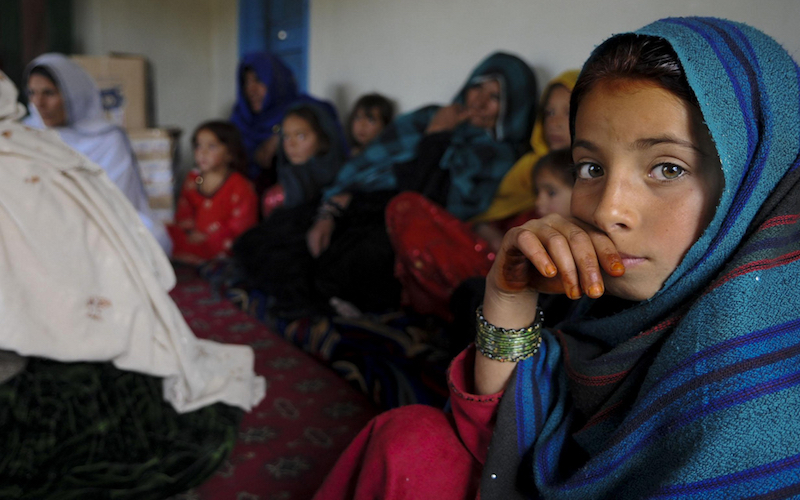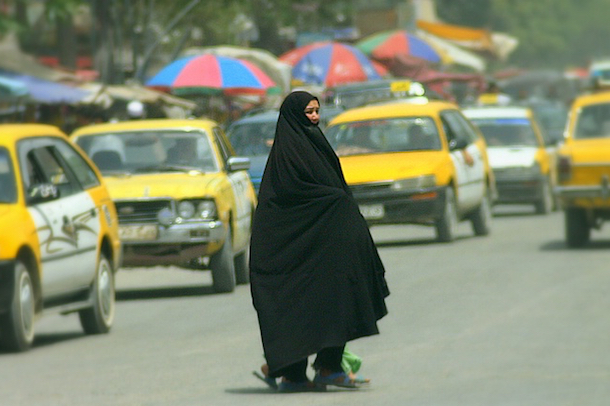
Strengthening Women’s Rights in Afghanistan
Gender inequality has remained a long-standing issue in many Middle Eastern cultures that has been exacerbated by terrorism. Although the Middle East is diverse with varying cultures, the region shares common challenges in securing gender equality, reproductive health rights, and women’s sexual autonomy. The root cause of Middle Eastern instability can be clearly drawn from the absence of women in societal roles and governments throughout much of the Middle Eastern region. Women are the future of the Middle East and U.S. investment in women’s equality — specifically through women’s health development initiatives — should be a top priority for both U.S. foreign aid and U.S. international security. A case study analysis of a United States non-government organization’s women’s health project in Afghanistan, provides an example of how U.S. government-funded health systems can impact gender equality within a community. Bringing this impactful service to scale across the region can be an effective method of increasing stability in the Middle East.
Not only does gender equality greatly impact the future of the Middle East. Scholars and activists agree that women are the future of the Middle East which lends support to the understanding of the centrality of gender equality to the future democratization of the Middle East region. A root cause for this inequality is anchored in the prevalence of Islamism within many Middle East governments.
Gender equality diminishes the effects of militant Islamic fundamentalism and its influence on those governments. A case can be made to support methods that strengthen gender equality in Middle Eastern countries. U.S. government (USG) investment in gender equality through health initiatives — particularly women’s health issues like family planning, prenatal care and antenatal care are proven methods that support gender equality. This, in turn, diminishes issues such as gender based violence (GBV), sexual violence, lack of education, and illiteracy which have led to unequal representation of women in societal and government roles. Through a case study analysis of a USG-funded women’s health project in Afghanistan, solutions and methods can be drawn from statistical outcomes to support additional U.S. strategies to strengthen international security and inter-state relations with Middle Eastern countries through methods of soft security.
The absence of women is the root cause of the instability shared throughout the region. One of the leading causes for this unequal representation is that laws do not support women. This lack of equality and representation is often tied to the extreme interpretations of Islamic law that still govern many Middle East nations. Whereas Western culture enhanced the roles of women through the Enlightenment period, much of the Middle East continues to implement severe gender discrimination. The issues of sexuality and gender equality continue to cause intense political discourse and social struggles in countries like Afghanistan. According to Pinar Ilkkaracan, “mobilization by the Islamic religious right, which started in the 1980’s and has intensified since 2001, has narrowed the space for progressive reforms in laws and policies, including in regard to sexuality.” This can be tied to the influence of sharia law on these political institutions.
When considering this lack of gender equality {specifically female representation} in societies and governments, a country cannot advance nor thrive when only utilizing half of its population. If women are not contributing to the economy due to an inability to access education and pursue paying jobs, the economy will inevitably fall short compared to other nations where contributions are made from the majority of the population. In countries where laws have not barred women from participating in societal or government roles, the economies are positively affected. For instance, in Palestine, women are very active in organizational, political, and social activities. Decreased gender-based restrictions allow these women to make contributions to their families and communities as well as invest in their children, homes and education. This has significantly impacted their status in their communities and contributed significantly to the economic health of the community.
In countries where women are active members and representatives in their communities, the impacts of militant Islamic fundamentalism are diminished. USG-funded activities that are operating in the Middle East region must implement gender-focused work into their NGO-led initiatives that will support the goals of women’s rights efforts in these countries. Funneling support toward these efforts to existing, NGO-led initiatives decreases the risk of funds going directly to the governments of these countries where government officials have their own agendas.
Funneling gender activities through USG-funded NGO health projects also benefits women at the micro level. Many USG-funded health projects are structured first at a community level and then scaled up to a national level where the benefits impact greater economic development for the whole population instead of only a privileged few.

Investment in gender equality through integration of gender issues into existing health initiatives that are led, funded, and/or implemented by USG global health projects. This idea is made possible due to the current U.S. involvement in global development initiatives throughout the Middle East. The framework already exists and the next step is integration of gender-related services starting on the community level. What begins in the home creates an impact on the community, which then scales up to the government level. Through taking steps that include male involvement in these health initiatives, these efforts are addressing the full scope of the gender inequality issue.
The impacts are seen through statistics that show significant increases in women’s access to health services and education. In Afghanistan, where only 57% of women had access to a health facility within one hour’s walk from their home, now over 95% of women have a health facility within that range. In 2015, as a result of USG-funded health initiatives in Afghanistan, over 560 thousand new female patients attended pre-natal care visits and 290 thousand births were attended to by skilled providers. This is a significant improvement in a country where only 18% of women are receiving four or more antenatal care visits and only 51% of women gave birth assisted by a skilled provider. USAID also supported the increase of the women’s health workforce through supporting health worker training. In 2002, only 25% of health facilities in Afghanistan had a female health worker (doctor, nurse or midwife). That percentage grew to 85% by 2015. The increase in female representation in the health workforce strengthens efforts for female access to healthcare.
The U.S. government is successfully reaching the high-risk population of women in Afghanistan and other Middle East countries threatened by similar risks caused by gender inequality. These women are accessing services for the very first time as a result. Through continued growth and funding, these services will continue to impact communities at a greater scale, resulting in more women accessing these services. The vessel now exists.
Afghanistan provides an accurate example of many of the worst cases of gender inequality that is widely present throughout the Middle East region. Only 15% of women are working outside their home. 86% of Afghan women are illiterate and only about 7% have received secondary education.
Through a national survey done by Central Statistics Organization in Afghanistan in 2015, the following statistics were gathered from men and women who were currently or at one time married. In relation to health care access inequality, 90% of women ages 15-49 reported experiencing at least one problem in accessing health care. Only 48% of women reported making decisions about their own healthcare. More directly related to gender-based violence, eight in ten married women and seven in ten married men surveyed in Afghanistan agreed that a husband is justified in beating his wife. 56% of married women surveyed have experienced spousal violence. An unsurprising statistic gathered by the Central Statistics Organization that accompanies those previously presented is that only 2% of households are headed by women.
USAID’s HSSP in Afghanistan
USAID answered the call to integrate gender equality efforts into health initiatives by defining gender as an official health area within women’s health. The following analysis follows the activities and outcomes of USAID’s Health Services Support Project (HSSP) that operated in the south and southeast regions of Afghanistan from July 2006 through October 2012.
USAID’s HSSP was led by three leading global health non-government organizations: Jhpiego, Save the Children, and Futures Group. Although the project’s objectives focused on areas outside of gender that included service delivery strengthening, increasing the number female healthcare providers in rural or underserved areas & improving capacity of patients healthcare decision-making abilities, this case study will be based on the outcomes of the fourth objective of integrating gender awareness and practice into the basic package of health services provided at the health facilities.
One of the first steps in implementation of gender awareness integration into healthcare services was to hire a male Gender Officer to lead the activities. By intentionally hiring a man, the position in itself was an attempt to promote the idea that gender should not only be a female issue.
This effort directly responds to a widespread misconception that implementation of gender into healthcare is only directed toward women who are often the victims of gender inequality. In most cases, this method of effort is backwards in that the women can only do so much with the tools and resources she received through the integration of her healthcare because she is living in an environment where she cannot speak for herself or her healthcare preferences like, for example, choice of contraception or preference of birthing environment.
A second major step HSSP took was to conduct research that would inform them of the knowledge, attitudes, and practices among the Afghan men and women that prevented women from seeking reproductive health services in the public health system. The survey audience included men and women ranging from a variety of demographics that included health professionals, schoolteachers, women or reproductive age, heads of household, village leaders, and religious leaders.
Some of the top findings from the survey research aligned with statistics shown by many international organizations. Finding included: lack of women’s decision-making power regarding health services, family planning decisions usually were made by male members of the family and mothers-in-law, women’s rights were not enforced by law enforcement, shortage of female healthcare staff at facilities, and lack of education for women created a barrier to partake in healthcare services, particularly in rural areas.
A third activity done by HSSP was the formation of Family Health Action groups that provided a forum for women to come together in an environment that was culturally appropriate and comfortable to them to discuss issues that were important to them. These groups equipped the women with knowledge to improve their ability to make decisions regarding their family’s basic health practices. The outcomes included women becoming informed on health issues surrounding pre-natal, antenatal, and post-natal/newborn health, which proved to save the lives of mothers and infants.
As the FHA groups were a major activity in integrating support to women in the community, HSSP also aimed their efforts toward the Afghan government through gender support to the Ministry of Public Health. They funded a new Ministry official, the Gender Advisor, whose responsibilities included pushing through gender-related policies and reforms. Additionally, HSSP integrated new gender-equal language and evaluation criteria for the Ministry to use when requesting service delivery grants from other funding organizations.
Lastly, the HSSP project contributed to increased gender equality by supporting the midwifery profession in Afghanistan by addressing the three main areas of gender inequality: reproductive health, empowerment, and economic activity. Increasing the amount of midwives with advanced skills and competencies regarding reproductive health and family planning led to reduction of maternal and infant mortality. The women who became midwives did so by receiving higher education and many became leaders in their organization and communities. Many of the midwives received jobs in the health facilities and started earning incomes that allowed them to support their families.
HSSP’s strategy aligned with global thought on integration of gender equality support by investing at the community level first through efforts such as the FHA groups, while also addressing the gender issues at the government level through the Ministry of Public Health. The FHA groups were an opportunity to involve women in discussions about their health. Increased knowledge and confidence regarding health care decisions may lead to an increase in the percentage of women who make decisions about her own health care.
Through the support of increased midwifery health workforce, not only are there more women in the communities who are working and earning an income, there are more women who are obtaining higher education. This helps with the abysmal Afghan women’s employment rate (15%).
Gender inequality is a root cause of turmoil, violence and instability in Afghanistan. The warped religious influences on governments that perpetuate this inequality lend to an environment throughout the country and a region that is more susceptible to the threats of extremist terrorism.
Leading political and scholarly thought around the world supports the idea that initiatives to address this inequality must be implemented on the community level through NGOs who are not at risk of being influenced by government agendas. One successful vessel of integration into some of the highest risk countries in the Middle East is global women’s health development initiatives funded by the U.S. government. Particularly in Afghanistan, current USAID-funded women’s health efforts are significantly improving the lives of women living in what were the most under-served areas of the country.
Increased gender equality will strengthen the unstable communities and governments that currently plague the Middle East, opening the door for further improvements to human rights issues as a whole. This will help to create stronger democracies, rendering terrorism and extremist ideologies unviable and unpalatable.

